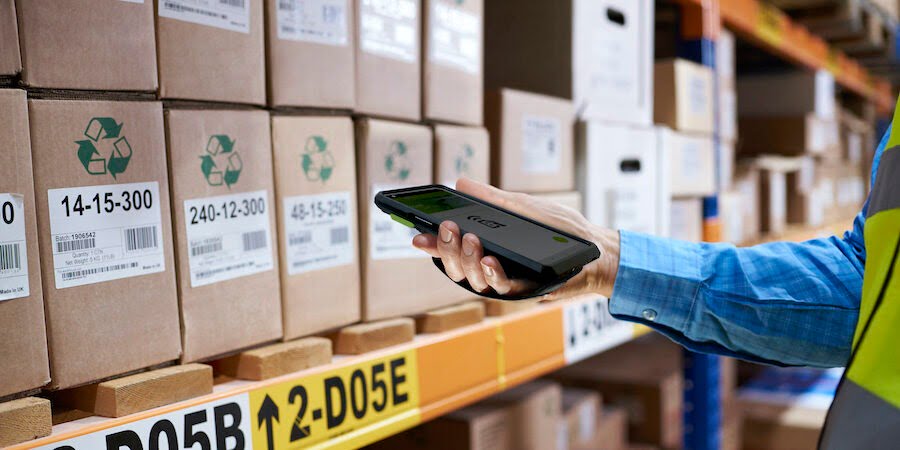Barcodes are essential for businesses in the delivery and tracking of goods. They can also control inventory since a barcode can count the stored items. The barcode is used in various companies, including healthcare and grocery stores, to identify products and categorize unique patient IDs. Without the barcode, purchasing would undoubtedly be much more challenging.
As customers, we frequently observe the use of barcodes and barcode scanners when making purchases from retail shops, factories, hospitals, and even visiting doctors. Barcodes are more than just a series of dots and dashes on a product.
Related article: RFID Asset Tracking in Hospitals
Businesses can track a staggering amount of data with barcode scanning devices, boosting production and efficiency. Understanding how barcodes function and learning how to use them successfully in collaboration with a high-quality barcode scanner will help you streamline your business’s operations.
What is Barcode and Barcode Scanner?
A barcode encodes data using a particular type of image. Barcode symbology describes the formatting used to encrypt data in an image or design. Although the black-and-white lines’ spacing and design appear random, they adhere to specified coding languages developed by the International Organization for Standards (ISO).
The information will then be converted into a line of text that can be read by a point of sale or inventory system via a barcode scanner once it has read the images, identified the code, and detected the code.
- 1D Barcode: One-dimensional (1D) or linear barcodes are the most well-known. The data on these labels is encoded using the traditional black-and-white parallel lines and spacing.
- 2D Barcode: The more recent two-dimensional (2D) barcodes convey data using squares or rectangles with black and white dots arranged patterns, known as a data matrix.
A barcode scanner can read an image made up of a collection of parallel black and white bars as a barcode. To readily identify products, barcodes are printed on them. Barcodes are frequently used in warehouses to track and manage inventory, in retail stores as part of the purchasing process, and on invoices to aid in accounting.
A barcode scanner is a tool that reads and decodes the data that a barcode contains. The four parts of a traditional barcode scanner are as follows:
- Light source: This enables the barcode to read and precisely decode the data it contains.
- Lens: This lens scans the barcode.
- Photoconductor: This device converts optical impulses into electrical ones and is a photoconductor.
- Decoder: Data from the barcode is decoded and sent to the output port of the scanner by the decoder.
Once the data is collected, barcode scanners connect to a host computer or tablet and broadcast it in real-time without further human involvement. It assists retailers with automating data collection procedures and decreasing human error in point-of-sale transaction processing and inventory tracking.
How Do Barcodes Work?
A barcode is a square or rectangular image of parallel black lines and white spaces, as is common knowledge. Each shaded line’s length and the distance between them serve as the encoding medium for the data. The distinctive bar of shaded lines is scanned into by a scanning instrument using a laser to “read” the bar code. The lines are read left to right using a barcode scanner.
A barcode scanner examines the binary information contained in the pattern of black and white bars (0 or 1). The data is only readable by computers in binary form, and the same is displayed on the monitor’s screen.
The barcode’s elements, often known as the mix of black and white bars, indicate different text characters that adhere to a predetermined algorithm (more on the types of barcodes later). This pattern of black and white bars can be read by a barcode scanner and converted into a line of test that your retail point of sale system can read.

Types of Barcodes:
UPC is one of the most widely used barcode kinds (Universal Product Codes). Retail products are labeled with the help of this barcode. Almost every sale item in the market and every grocery store in the US has it. It is a 12-digit number with just numeric characters. The first six digits of the barcode are unique numbers that GS1 assigns to each product. Each product has a distinct UPC that its producers use to identify it.
Thanks to this, users may monitor where their stuff is and when they will receive it. Other forms of barcodes are as follows:
- UPC
- Codabar
- Code 39
- Code 93
- Code 128
- ITF-14
- GS1-128
- MSI Plessey
- EAN-13 and EAN-8
UPC: UPC barcodes are used to label and scan consumer goods at points of sale. Twelve numerical digits are encoded by the UPC-A variant, but only six are encoded by the UPC-E variant. UPCs speed up inventory tracking in retailers and warehouses and the checkout process. UPCs, enable tracking products accurately and effectively from production to distribution.
Codabar: Codabar is very simple-to-print and is utilized in US blood banks, photo labs, and air bills. It can be created manually by using consecutive digits and encrypts up to 16 characters. A self-checking barcode is also included. It will mark false data as a wrong scan rather than scanning incorrect data, minimizing scanning errors.
Code 39: Code 39 permits the use of both characters and numbers. The fact that it could only encode about 39 characters is where its name came from. But as of right now, that number is 43. It is most frequently employed by the American Department of Defense and the automotive industry.
Code 93: In logistics, code 93 barcodes are used to label electronic parts, identify goods in retail inventory, and even use in the Canadian Post for additional delivery information. Code 93 barcodes provide complete ASCII capability, much like Code 39. The high density and small size of Code 93s enable additional protection within the code itself and make them approximately 25% shorter than barcodes created in Code 39.
Code 128: This barcode is more recent, and it can encrypt any character in the ASCII 128-character set. You can utilize a variety of characters because it can encode integers, letters, and pronunciation marks. Because of this, it is a strong barcode that can hold virtually any data type. It is used chiefly for orders, transportation, and logistics distribution.
ITF-14: This barcode is a hybrid of logistical and point-of-sale barcodes. It is capable of handling high printing tolerances and employs a 14-digit number. It is beneficial if you need to print barcodes on cardboard. This barcode is typically used for transactions involving non-point-of-sale (POS) products.
GS1-128: This barcode was developed as a data carrier to make it easier for businesses to send information to one another. It comes with a collection of application identifiers that allow it to describe the meaning of the data as well as encode it.
MSI Plessey: MSI Plessey (or Modified Plessey) barcodes are used to label supermarket shelves and control inventory in retail settings. They are also utilized throughout warehouses and other storage facilities to facilitate precise inventory checking. MSI Plessey codes can be generated at any length and can only encode integers; therefore, they can encode almost any quantity of data. Additionally, compared to newer, more affordable barcodes, its binary format is less trustworthy and effective.
EAN-13 and EAN-8: These barcodes are frequently utilized in other regions rather than the United States. At the point of sale, they are scanned and are frequently found on consumer goods like food, shoes, and clothing. Both EAN-13 and EAN-8 have 13 and 8 digits, respectively. The latter is beneficial for scanning items like confectionery with limited label space.
Various Barcode Combinations:
Lines of varying widths represent a 12 or 13-digit number in barcodes. Because of this, there are up to ten trillion various combinations. There are two sorts of barcodes: two-dimensional matrix barcodes and linear barcodes.
- 1-Dimensional or Linear Barcodes: These are made up of lines and gaps with different widths and produce patterns. UPC barcodes are one type of linear barcode.
- 2-Dimensional or Matrix Barcodes: Contrarily, Matrix barcodes are a two-dimensional kind of data representation. They are comparable to linear barcodes but can encode more data in each space. They resemble squares or rectangles with numerous small dots inside. Countless possible combinations can be used to encode data for barcodes.
Benefits of using Barcodes:
Although barcodes were first created to expedite the sales and transaction process, they also provide many other advantages.
- Greater Accuracy: When processing a product’s data, a barcode is significantly more precise than a sales associate manually entering that data, which is prone to error.
- Low implementation costs: Barcode generation is rapid and easy, and because transactions are completed more quickly and accurately thanks to increased inventory and sales data, shops can anticipate savings after deployment.
- Improved Inventory Management: Retailers benefit from quicker cycle counts and more precise inventory turnover estimates because of greater accuracy and real-time data.
- Real-time Data: The speed at which the information is processed allows for the instant availability of information on inventory levels and sales.

What is a Universal Product Code (UPC)?
UPC barcodes are used to label and scan consumer goods at points of sale. Twelve numerical digits are encoded by the UPC-A variant, but only six are encoded by the UPC-E variant. A UPC (universal product code) is a code written on the packaging of retail products to aid in their identification. A UPC comprises a machine-readable barcode (a series of black bars) and the unique 12-digit number beneath the barcode.
When a barcode is scanned at the point of sale, the scanner reads the UPC and instantly searches for that number in the retailer’s inventory management and point-of-sale systems. These systems are frequently identical.
From there, the point of sale or warehousing system can provide the name, description, price, and other database-stored details of the related product. Systems can store a lot of information about a product because the UPC is a unique identifier.
What are the purpose and advantages of UPC?
When a product is scanned at the register, its name, item type, size, and color can all be easily determined, thanks to UPCs. Although they were initially developed to speed up checkouts at grocery shops, they are now frequently used to manage inventory in warehouses and retail establishments.
Utilizing UPCs has many benefits for both customers and businesses. UPCs, speed up checkout since they enable barcode scanners to read a product’s price and UPC. They successfully eliminate the requirement for manual product information entry.
UPCs also facilitate better inventory management and tracking. They assist retailers in determining whether they need to keep more of a specific product in stock, either on their shelves or in their warehouse.
Final Thoughts:
Barcodes are a necessity if you own a business. You can list your products in warehouses, distributors, or retail stores with them. You cannot simply make up your barcode numbers, and you should never purchase used barcodes. When your numbers conflict with someone else’s, doing one of these actions can result in serious issues.
Fortunately, registered, one-of-a-kind barcodes are widely available and reasonably priced. With the Global Trade Item Number (GTIN) system, a standardized international system was established years ago to guarantee that everyone could obtain a distinctive barcode. Customers profit from barcodes and help retail establishments function more effectively. For retailers, barcodes speed up and improve the accuracy of selling and inventory management while also providing intense supervision of business performance.
Related article: How to Improve Your Hospital Asset Management Plan in 2022
FAQs:
What do the numbers in a barcode mean?
The barcode’s manufacturer identification number is the first six numbers. The item’s number is shown in the next five digits. The last digit also called a check digit, allows the scanner to verify whether the barcode was correctly scanned. The barcode numbers are specific to the item you are purchasing. A UPC-A barcode has 12 numbers as standard. Here is what the numbers represent:
- The first digit is the system identification, which helps classify the product type.
- The numbers 0, 1, 6, 7, and 8 are standard Universal Product Codes.
- The number 2 designates weighed commodities.
- The number 3 designates items that are connected to health.
- The number four is set aside for non-food things.
- Coupons are designated by the numbers 5 and 9.
There are two groups of five numbers in the middle after the first digit. The first set relates to the product number and the second set to the manufacturer number. The last digit is a control digit used to scan for faults.
Do barcode scanners read the black or white bars?
Scanners can distinguish between the contrasts of black and white (or whatever colors are in use). In general, it matters how wide the bars are in both colors. The scanner needs to find out how far it is from the barcode. Still, it can measure angular distance or the number of pixels in one bar compared to another, making the relative width of the bars more significant than the absolute width. The relative width of a bar in the start or stop sequence may be known after the reading.
Can a barcode tell you what the product is?
A product’s price, weight, production and expiration dates, manufacturer’s name, and other details are all contained in a barcode. To allocate barcodes, an international organization has been set up. There is a distinct barcode on every product in the world.























